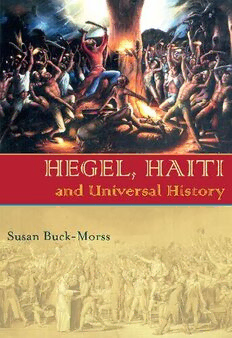
Hegel, Haiti and Universal history PDF
Preview Hegel, Haiti and Universal history
H E G E L , H A I T I a n d U n i v e r s a l H i s t o r y Susan Buck Morss HEGEL, HAITI, and Universal History Illuminations: Cultural Formations of the Americas John Beverley and Sara Castro-Klarén, Editors HEGEL, HAITI, and Universal History Susan Buck-Morss UNIVERSITY OF PITTSBURGH PRESS Published by the University of Pittsburgh Press, Pittsburgh, Pa., 15260 Copyright © 2009, University of Pittsburgh Press All rights reserved Manufactured in the United States of America Printed on acid-free paper 10 9 8 7 6 5 4 3 2 1 Library of Congress Cataloging-in-Publication Data Buck-Morss, Susan. Hegel, Haiti, and Universal History / Susan Buck-Morss. p. cm. — (Illuminations : cultural formations of the Americas) Includes bibliographical references and index. ISBN-13: 978-0-8229-4340-2 (cloth : alk. paper) ISBN-10: 0-8229-4340-9 (cloth : alk. paper) ISBN-13: 978-0-8229-5978-6 (pbk. : alk. paper) ISBN-10: 0-8229-5978-X (pbk. : alk. paper) 1. Hegel, Georg Wilhelm Friedrich, 1770–1831. 2. Haiti—History— Revolution, 1791–1804. 3. Slavery. 4. History—Philosophy. I. Buck-Morss, Susan. Universal history. II. Title. III. Title: Universal history. B2948.B845 2009 193—dc22 2008048901 CONTENTS List of Illustrations vii Preface ix Part One: Hegel and Haiti Introduction to Part One 3 Hegel and Haiti 21 Part Two: Universal History Introduction to Part Two 79 Universal History 87 Bibliography 153 LIST OF ILLUSTRATIONS Part One figure1. Lichtputze (Candlewick Cutter) 7 figure2.Frontispiece to the 1785 edition of Daniel Defoe’s 1719 novel, Robinson Crusoe. Illustrated by Mather Brown, engraved by Robert Pollard 11 figure3.Franz Hals, Portrait of a Dutch Family,1648 27 figure4.Sir Peter Lely, Elizabeth Countess of Dysart,c. 1650 30 figure5.Anthony van Dyck, Henrietta of Lorraine,1634 31 figure6.Cover page of Minerva 46 figure7.Wordsworth’s sonnet Morning Post, 2 February1803 47 figure8. “A Temple erected by the Blacks to commemorate their Emancipation.” Line engraving by J. Barlow 66 figure9.French masonic apron, late eighteenth century 67 figure10.Cosmological diagram, French Freemasonry, lateeighteenth century 70 figure11.Cosmological diagram, Haitian Vodou, twentieth century 70 figure12.Two-headed eagle, crowned, emblem of the Supreme Council of 33 degrees, French Freemasonry, eighteenth century 71 figure13.Seneque Obin, Haitian Lodge Number6,1960 71 figure14.Two-headed eagle, crowned, line drawing of watermark on paper 72 figure15.Two-headed eagle, crowned, watermark on paper 72 vii list of illustrations Part Two figure16.Jean-Michel Moreau le Jeune, Illustration for Voltaire’s Candide,1787 81 figure17.Pin Manufactory(Epinglier) 98 figure18.Sugar Manufactory(Sucrerie) 99 figure19. Vodou ceremony, 1970. Photo by Leon Chalom 124 figure20. Masonic initiation ceremony, late nineteenth century 125 figure21. Hector Hyppolite, “An Avan, An Avan!” (Forward, Forward!),c. 1947 130 figure22. Ulrick Jean-Pierre, Painting entitled Bois Caïman1 (Revolution of Saint-Domingue, Haiti, August 14, 1791), 1979. Oil on canvas, 40 x60 in. 135 figure23. Jacques-Louis David, “The Tennis Court Oath at Versailles,” n.d. Sketch 140 viii PREFACE “Hegel and Haiti” was something of an intellectual event when it appeared in Critical Inquiryin the summer of 2000. The essay’s un- expected movement through art catalogues, political journals, foreign translations, internet blogs, workers’newspapers, and college class- rooms was in response to the unconventional topologies of time and space that it mapped out, perhaps more in tune with how we actually live our lives than the histories of separate pasts we have been taught. I am grateful for the interest and generosity of scholars, artists, and activists who found it useful in a variety of contexts, and from whom I have learned a great deal. The essay has generated controversy as well. It pleased the academic critics of Eurocentrism, but not en- tirely. While decentering the legacy of Western modernity (that was applauded), it proposed the less popular goal of salvaging moder- nity’s universal intent, rather than calling for a plurality of alterna- tive modernities. For some, the very suggestion of resurrecting the project of universal history from the ashes of modern metaphysics appeared tantamount to collusion with Western imperialism—or per- haps more precisely, American imperialism, a more abstract and some would say insidious form. A second essay, “Universal History,” appears here in response to the critics of the 0rst. Far from recanting the earlier argument, it develops the most controversial claims. It writes history as politi- cal philosophy, assembling material related to “Hegel and Haiti” that changes what we think we know about the past, and therefore how we think the present. There is political urgency to this project. ix
